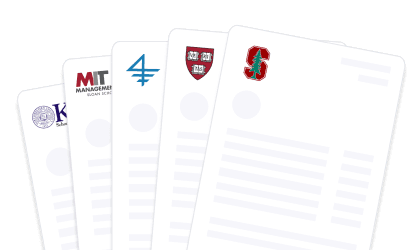
Table of Contents
Free Event

Featuring Melanie E.
How to Get a Head Start on Your MBA Application
Starting Wednesday, April 16
10:00 PM UTC · 60 minutes

Featuring Melanie E.
The Stanford GSB Employment Report provides valuable insights into the employment landscape for graduates of the Stanford Graduate School of Business. This report is a comprehensive analysis of employment trends, salary data, geographic distribution, job roles, and the impact of a Stanford GSB degree on employment outcomes. Understanding the key findings of this report can help prospective students, current students, and alumni gain a better understanding of career opportunities and make informed decisions.
What is the Purpose of the Stanford GSB Employment Report?
The Stanford GSB Employment Report serves as a resource for students, alumni, recruiters, and other stakeholders to understand the employment outcomes of Stanford GSB graduates. It provides detailed information about the sectors, geographic distribution, job roles, and salaries of graduates, allowing stakeholders to evaluate the effectiveness of the Stanford GSB program.
By examining the employment outcomes of Stanford GSB graduates, the report offers valuable insights into the success of the program in preparing students for the job market. It allows current and prospective students to make informed decisions about their career paths and helps alumni gauge the impact of their Stanford GSB education on their professional lives.
Methodology Used in the Report
The report is based on data collected from Stanford GSB graduates through surveys and other sources. The data collection process is rigorous and thorough, ensuring that the information presented is accurate and reliable. Surveys are designed to capture a comprehensive range of employment data, including industry-specific details, job functions, and compensation packages.
In addition to surveys, the report also incorporates data from various external sources, such as employer databases and public records. This multi-faceted approach ensures that the report provides a comprehensive view of the employment landscape for Stanford GSB graduates.
Once the data is collected, it undergoes a meticulous analysis process. Statistical techniques are employed to identify trends and patterns in the employment outcomes, allowing for a deeper understanding of the factors that contribute to success in different industries and job roles.
It is important to note that the report represents a snapshot of employment outcomes and may not capture the full range of opportunities available to graduates. The job market is dynamic and constantly evolving, and individual experiences may vary. However, the report serves as a valuable tool for understanding the overall employment landscape and trends for Stanford GSB graduates.
Major Findings from the Stanford GSB Employment Report
Sector-wise Employment Trends
The report highlights the sectors where Stanford GSB graduates find employment. It provides insights into the changing demand for different skillsets and industries. This information can help students align their career goals with sectors that have a higher demand for professionals with their skillset.
Furthermore, the report delves into the specific job functions within each sector, shedding light on the diverse range of roles that Stanford GSB graduates secure. From finance and consulting to technology and entrepreneurship, the employment report showcases the wide array of opportunities available to graduates in various sectors.
Moreover, the report goes beyond just listing the sectors and job functions. It delves into the specific companies that have been hiring Stanford GSB graduates, providing students with valuable insights into the organizations that value the skills and education offered by the school. This information can be instrumental in guiding students towards potential employers and networking opportunities.
Salary Trends Among Graduates
The report includes data on the salaries of Stanford GSB graduates, allowing individuals to understand the earning potential associated with different industries and job roles. This information can help students assess the return on investment of their education and make informed decisions about career paths.
Furthermore, the report breaks down the salary data by various factors such as years of work experience, geographic location, and industry. This level of granularity provides students with a comprehensive understanding of how different variables can impact their earning potential. For example, students can analyze how their salary prospects may change based on whether they choose to work in New York City or Silicon Valley, or how their earning potential may increase as they gain more work experience.
In addition to salary data, the report also explores other compensation components such as bonuses, stock options, and benefits. This comprehensive view of the total compensation package can help students evaluate the overall value of different job opportunities and negotiate effectively when it comes to job offers.
Geographic Distribution of Employment
Domestic vs International Employment
The report provides valuable insights into the geographic distribution of employment for Stanford GSB graduates. It not only highlights the percentage of graduates who secure employment domestically versus internationally but also delves into the factors that contribute to this distribution. Understanding the global reach of the Stanford GSB program is crucial for students as it opens up a world of opportunities and allows them to explore diverse regions.
When it comes to domestic employment, the report reveals fascinating details about the various industries and sectors where Stanford GSB graduates find success. From finance and consulting to technology and healthcare, the program equips students with the skills and knowledge needed to excel in a wide range of fields. This diversity in employment options within the domestic market showcases the versatility of a Stanford GSB education.
On the international front, the report sheds light on the countries and regions where Stanford GSB graduates make their mark. It explores the cultural, economic, and political factors that attract these graduates to international opportunities. By understanding the geographic distribution of international employment, students can gain a deeper appreciation for the global impact of the Stanford GSB program.
Popular Cities for Stanford GSB Graduates
Aside from analyzing the domestic and international employment distribution, the report also identifies the specific cities where Stanford GSB graduates tend to find employment. These cities serve as hubs of opportunity, offering a higher concentration of job prospects for graduates. By examining the popular cities, students can gain insights into the dynamics of different job markets and evaluate potential relocation options.
One city that stands out in the report is New York. Known as the financial capital of the world, New York attracts a significant number of Stanford GSB graduates who are interested in finance, investment banking, and private equity. The city's bustling atmosphere and vibrant business community provide an ideal environment for these graduates to thrive and make a meaningful impact.
Another city that emerges as a popular destination for Stanford GSB graduates is San Francisco. With its booming tech industry and entrepreneurial spirit, San Francisco offers a wealth of opportunities for graduates interested in startups, venture capital, and technology companies. The city's proximity to Silicon Valley further enhances the potential for networking and collaboration.
London, the financial hub of Europe, also features prominently in the report. Many Stanford GSB graduates are drawn to London's global financial markets, prestigious consulting firms, and multinational corporations. The city's rich history, diverse culture, and international outlook make it an attractive destination for those seeking a truly global experience.
These are just a few examples of the popular cities where Stanford GSB graduates find employment. The report provides a comprehensive overview of the geographic distribution of employment, allowing students to gain a deeper understanding of the opportunities available to them and make informed decisions about their career paths.
Job Roles and Industries
Top Industries for Stanford GSB Graduates
The report presents the industries that employ a significant number of Stanford GSB graduates. This information can help students identify industries that align with their interests and skills. It also provides insights into sectors that have a high demand for graduates with a Stanford GSB education.
Stanford GSB graduates have found success in a wide range of industries. One prominent industry that has attracted many graduates is the technology sector. With its rapid growth and constant innovation, technology companies offer exciting opportunities for those with a Stanford GSB education. Graduates have taken on roles in leading tech companies, such as Apple, Google, and Facebook, where they have contributed to groundbreaking projects and played a vital role in shaping the future of technology.
Another industry that has seen a significant number of Stanford GSB graduates is finance. Graduates have secured positions in top investment banks, private equity firms, and hedge funds, where they have utilized their financial acumen and strategic thinking to drive business growth and make impactful investment decisions. Their Stanford GSB education has equipped them with the skills needed to navigate the complex world of finance and excel in demanding roles.
In addition to technology and finance, Stanford GSB graduates have also made their mark in the healthcare industry. With a focus on innovation and improving patient outcomes, graduates have taken on leadership roles in pharmaceutical companies, healthcare consulting firms, and healthcare startups. Their deep understanding of business strategy combined with their knowledge of the healthcare landscape has allowed them to drive positive change and make a difference in the lives of patients.
Common Job Roles for Graduates
The report explores the job roles that Stanford GSB graduates typically assume. It sheds light on the responsibilities, duties, and expectations associated with these roles. This information can help students develop a better understanding of potential career paths and the skills required for success.
One common job role that Stanford GSB graduates often pursue is that of a management consultant. In this role, graduates work closely with clients to solve complex business problems and drive organizational change. They use their analytical skills, strategic thinking, and strong communication abilities to provide valuable insights and recommendations to clients across various industries.
Another popular job role for Stanford GSB graduates is that of a product manager. In this role, graduates are responsible for overseeing the development and launch of new products or services. They work closely with cross-functional teams, including engineering, design, and marketing, to ensure the successful execution of product strategies. Their ability to understand customer needs, identify market opportunities, and make data-driven decisions makes them invaluable assets to companies looking to innovate and stay ahead of the competition.
Furthermore, many Stanford GSB graduates pursue careers in entrepreneurship. Armed with their business knowledge and entrepreneurial mindset, graduates have founded successful startups in various industries. They have taken risks, identified market gaps, and built innovative solutions to address pressing challenges. Their Stanford GSB education has provided them with the skills and network necessary to navigate the entrepreneurial journey and create impactful ventures.
Impact of the Stanford GSB Degree on Employment
Employment Rate Post Graduation
The report provides data on the employment rate of Stanford GSB graduates within a specific time frame after graduation. This information can help students gauge the effectiveness of the program in terms of securing employment in a competitive job market.
Influence of the Degree on Salary
The report explores the impact of a Stanford GSB degree on the salaries of graduates. It compares the salaries of Stanford GSB graduates to those of individuals without an advanced degree. This information can help students understand the value of a Stanford GSB education in terms of salary potential.
By analyzing the key insights and takeaways from the Stanford GSB Employment Report, individuals can gain valuable information to make informed decisions about their education and career paths. The report provides a comprehensive overview of the employment landscape for Stanford GSB graduates, allowing individuals to understand the trends, opportunities, and potential outcomes associated with a Stanford GSB education.
Final Note
Leland provides you with the coaching, content, and community that you need to get into Stanford GSB MBA program and accomplish other ambitious goals. Sign up today to gain access to additional free resources, community events, small group classes, world-class coaching, and more.


















